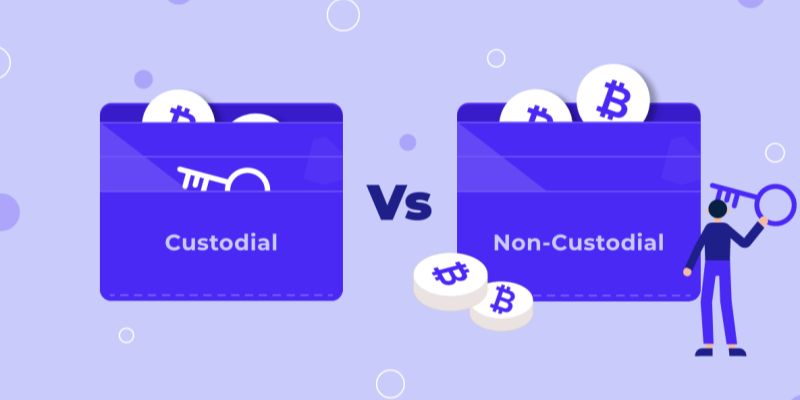Stepping into the digital currency space, you’ve likely pondered custodial vs non-custodial wallets (and how to create each). Let’s cut through the fog and get you set up right. Custodial wallets hand over the keys to someone else, much like keeping your cash at a bank. Non-custodial wallets? They empower you with full control, like a safe in your home. My mission here is simple: I’ll lead you through defining each wallet type, and then walk you through the nitty-gritty of creating your own crypto stronghold. Buckle up for a crash course that’ll turn wallet woes into crypto clarity.
Understanding Custodial vs Non-Custodial Wallets
Defining Custodial Wallets and Their Uses
Custodial wallets are like a bank. A third party keeps your money safe. You trust them. They manage keys and security. It’s easy to use. Think of crypto exchange wallets. They hold your assets. Great for beginners. But remember, you’re not holding the keys.
Deciphering Non-Custodial Wallets and User Autonomy
Non-custodial wallets give you full control. You’re the boss here. Your keys, your coins. Think self-hosted crypto wallets. They’re for those who value security and freedom deeply. With great power comes great responsibility, though. You must manage your keys and backups safely.
Now let’s dig in a bit more.
In the world of crypto wallets, knowing who holds the keys to your digital treasures is pivotal. When we talk about custodial wallets, think of these as being maintained by service providers. These providers, often exchanges or online wallet services, keep your crypto under their care. This route is convenient since you don’t have to worry about losing your keys – the wallet provider manages that risk for you. If simplicity and quick access to trading platforms are what you’re after, a custodial option like those offered by crypto custodial services might be your best bet. Their main perks are the user-friendly interfaces and the quick transaction times.
Nonetheless, it’s essential to understand that custodial wallet providers also maintain control over your assets, which includes overseeing the private key management linked to your wallet. This means if the provider suffers a breach, your digital assets are at risk. Plus, since they often require identification, say goodbye to anonymity with your transactions.
Switching gears, let’s talk about non-custodial wallet definition. These wallets give you total sovereignty over your cryptocurrency. They are essentially trustless cryptocurrency management solutions, where trustless means you don’t have to rely on a third party to keep your assets secure – it’s all on you.
The process of setting up a non-custodial wallet places safety directly in your hands. Decentralized finance (DeFi) storage, for instance, is a prime example of a non-custodial approach, often involving a blockchain wallet with features that only you can access, as you hold the private keys and recovery phrases.
Creating a non-custodial wallet involves more steps than its custodial counterpart. They can range from straightforward mobile or web applications to more secure physical hardware wallets. Cold storage wallets, like hardware options or paper wallets, are considered the gold standard among non-custodial solutions for their offline security benefits. Conversely, hot storage wallets remain online and are more suited to funds you might need to access or trade frequently.
So, when comparing wallet types, you’re looking at a trade-off between convenience and control. Custodial wallets are simple to use and are often the first step for many entering the crypto space. On the flip side, non-custodial wallets offer the advantages of complete control and better security, assuming you’re up for the task of managing your security protocols, like wallet encryption techniques and understanding the seed phrase importance for recovery.
Remember, cryptocurrency storage solutions are not a one-size-fits-all deal. Your choice between custodial and non-custodial wallets should weigh security, ease of use, and your personal comfort with taking on the mantle of safeguarding your digital wealth. Whether you opt for a hosted digital wallet environment or decide to take the plunge with user-controlled crypto wallets, always keep crypto wallet security at the forefront of your strategy.

Setting Up Your Wallets: A Step-By-Step Guide
Creating a Custodial Crypto Wallet
Getting your own custodial wallet is easy. First, pick a service you trust. Many people use crypto exchanges for this. Think of it like a bank. They keep your crypto safe for you. You sign up, give some personal info (that’s the KYC or Know Your Customer process), and create your account. This process does usually mean less privacy, but the exchange handles your security.
To start, make a strong password. Something tough for others to guess. Then, set up two-factor authentication (2FA) for extra safety. Your custodial wallet provider will keep your private keys. But don’t worry. If you forget your password, you can often reset it. That’s one of the benefits of custodial wallets.
Establishing a Non-Custodial Wallet
Non-custodial wallets put you in full control. That means you’re in charge of your wallet’s private key. It’s like being your own bank. This setup might sound tough, but let’s break it down.
First, download a wallet app or buy a hardware wallet. Apps are free and easy to find. Hardware wallets cost money but offer even more security. When you set up your wallet, you’ll get a seed phrase. This is a list of words that lets you recover your wallet if needed. Write it down. Keep it safe. Don’t share it with anyone.
Next, encrypt your wallet. This adds a password to open or send crypto. Always use a unique and strong password. Now you’ve got a non-custodial wallet that no one else can crack open. Keep your software updated, and always back up your wallet to protect your coins.
Creating a custodial crypto wallet is about ease and convenience. Setting up a non-custodial wallet is about having full control and taking the lead on security. Choose the one that matches your needs for help, control, and privacy. With these steps, you’re all set to dive into the world of cryptocurrencies, armed with the right wallet for your journey.

Enhancing Crypto Wallet Security
Best Practices in Private Key Management
Your private key is like the secret code to your crypto wealth. Keep it safe. It’s that unique line of numbers and letters that unlocks access to your stash. If someone gets it, they get your coins. So, you should guard it with your life.
Here’s the low-down on best practices: First, never share your private key. It’s meant for your eyes only. Second, avoid keeping it on devices that touch the internet. Why? More connections, more chances for thieves to grab it. Go for paper or hardware wallets to store this key—they’re not connected, so they’re safer.
When you set up a new wallet, you’ll get this key. Make sure you write it down right away. Always have backups in places you trust. Think safety deposit boxes or a home safe. And don’t just have one copy. Having a couple secure backups means you’re safe if one goes missing.
The Role of Encryption and Seed Phrases in Wallet Security
Encryption turns your private key into a code that’s hard to crack. It’s like turning your key into a puzzle that only you know how to solve. Wallets often ask for a password to add another lock on your crypto.
Seed phrases, also known as recovery phrases, are a wallet lifesaver. These are words given to you when you create a wallet. They’re not just any words—they put the power to get your crypto back in your hands if you forget a password or lose a device.
Remember, write down your seed phrase and keep it super safe, just like your private key. Without these words, you’re out of luck getting into your wallet if things go sideways. And since we’re keeping things simple, think of your seed phrase as your crypto backdoor. Lose your keys? This backdoor gets you back in.
Here’s a tip: Don’t store your seed phrase on a computer or phone. Old-school paper is your friend here—it can’t be hacked. Also, don’t just snap a photo or shout it out online. Keep that phrase under wraps and offline.
By mastering private key care and understanding encryption plus seed phrases, your crypto wallet is a fortress. Sure, this stuff might seem complex at first glance. But really, it’s all about keeping secrets—your keys and phrases—from the bad guys. Keep them under lock and key, and your digital treasure is protected.

Comparing Wallet Storage Solutions
Cold Storage vs Hot Storage Wallets
Cold storage wallets keep crypto offline. Hot storage wallets stay online. That’s their big difference. I find cold storage like a safe. You put in stuff you don’t need right away. It’s safe there but not easy to grab. Hot storage, though, is like your wallet. You use it for money you spend often.
A cold storage wallet is the go-to for holding crypto safely for a long time. It’s away from hackers because it doesn’t touch the internet much. Think USB drives or special offline computers. For your big crypto stash, cold storage is a smart move.
Now, hot storage wallets are great for daily use. They’re connected to the internet so you can trade or spend crypto fast. Smartphone apps, web wallets, and desktop software are all hot wallets. They’re convenient, but remember they’re riskier too. More internet use means more chances for thieves to try to break in.
My advice? Use both. Keep most of your crypto in cold storage, but have a little in hot storage. That way, you’re safe and ready to go.
The Advantages of Multi-Signature and Hardware Wallets
Multi-signature wallets need more than one key to access. Think of it like a lockbox where two keys are better than one. It stops one person from making a mistake or doing something wrong with the money.
These wallets are great when you team up with others. Everyone can check a transaction before it happens. And it also means no single person’s mistake or theft can hurt you. For businesses or groups, multi-signature wallets offer great control and peace of mind.
Now, let’s talk about hardware wallets. They’re like a cold storage wallet, but usually fit in your pocket. They can connect to your computer when you need them. They keep private keys locked away inside, never showing them to your computer or the internet. This means even if your computer has a virus, your crypto is still safe.
People love hardware wallets because they give you the best of both worlds. They’re safer than hot wallets but easier to use than other cold storage. Plus, many come with backup options. You can recover your crypto even if you lose the wallet.
In the crypto world, a one-size-fits-all doesn’t work. Between hot and cold, custodial and non-custodial, and different tech like multi-signature or hardware, your choices matter. Think about how you use your crypto and choose the best mix for you. And always remember one rule: Keep your keys safe, because in the end, they’re your ticket to your digital treasure.
In this post, we went deep into custodial and non-custodial wallets. We saw how custodial wallets are easy, but less in your control. Non-custodial wallets give you more power but come with big responsibilities.
I walked you through setting up both kinds of wallets. Remember, creating them is only the start. Keeping them safe is most critical. I told you how to use private keys the right way. I also explained why encryption and seed phrases matter a lot.
Lastly, we compared cold and hot storage. I showed you how multi-signature and hardware wallets can further protect your coins.
Here’s my final take: Picking a wallet is about balance. Ease against control. Convenience versus security. Always choose what fits your crypto life best. Stay informed, stay safe, and keep your coins under lock and key!
Q&A :
What are the main differences between custodial and non-custodial wallets?
Custodial wallets are digital wallet services provided by a third-party company that maintains control of the user’s private keys. In contrast, non-custodial wallets are those where the individual user has exclusive control over their private keys. Custodial wallets are often user-friendly and provide a high level of customer service, while non-custodial wallets offer greater security and autonomy since the user is the only one with access to their assets.
How do I set up a non-custodial wallet?
Setting up a non-custodial wallet typically involves the following steps:
- Downloading the wallet software or app from a trusted source.
- Creating a new wallet within the application.
- Securely recording the recovery phrase or seed – a set of 12-24 words that allows you to recover your wallet.
- Setting a strong password for wallet access if required by the wallet application.
- Backing up your recovery phrase securely, separate from your device.
Remember to keep your recovery phrase confidential, as anyone with access to it can take control of your wallet.
What are the benefits of using a custodial wallet?
Custodial wallets come with several benefits, including:
- Convenience: These wallets are typically easier to set up and use for everyday transactions.
- Recovery options: If you forget your password or lose access to your account, the service provider can help you regain access.
- Additional services: Many custodial wallets offer integrated services such as fiat-to-crypto exchanges, interest accounts, and more.
However, these benefits come at the cost of having to trust a third party with your private keys.
How do I create a custodial wallet?
To create a custodial wallet, follow these steps:
- Choose a reputable custodial wallet provider.
- Sign up for an account on the provider’s platform, typically requiring an email and password.
- Complete any required security checks, such as two-factor authentication.
- Deposit cryptocurrency into your wallet through purchase, transfer, or exchange services offered by the provider.
It’s important to thoroughly research the provider’s security measures and reputation before entrusting your assets to them.
What should I consider when choosing between a custodial and non-custodial wallet?
When choosing between a custodial and non-custodial wallet, consider the following factors:
- Security: Assess your comfort with entrusting a third party with your private keys versus your ability to secure your keys yourself.
- Convenience: Determine if ease of use is worth the potential security trade-offs of a custodial wallet.
- Control: Decide if having complete control over your assets is a priority for you.
- Support: Non-custodial wallets often have less customer support available, so consider how much assistance you might need.
By weighing these considerations, you can select the type of wallet that best fits your comfort level and cryptocurrency needs.


